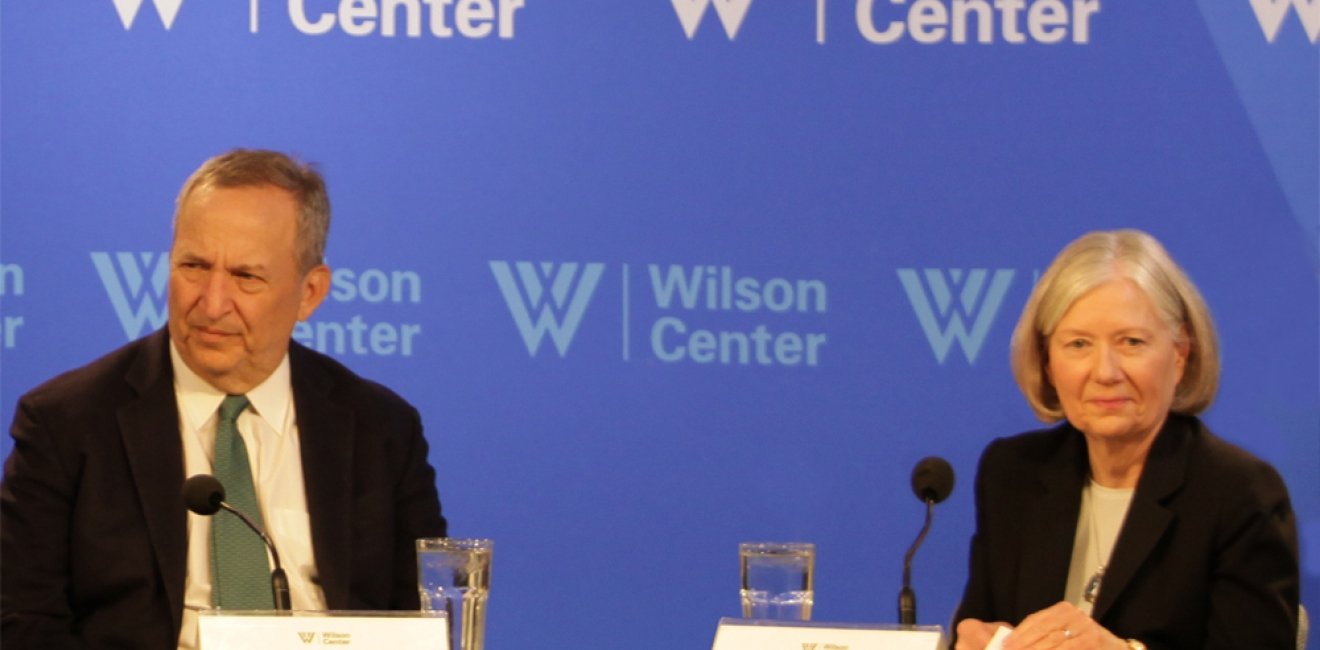
A blog of the Indo-Pacific Program
Over two decades have passed since what started as a currency issue in a Thailand quickly spiraled into a financial crisis that enveloped over a dozen countries in Asia. Through years of concerted intervention by both governments and commercial interests, including the International Monetary Fund, the region was stabilized. Asia is now the world’s most economically dynamic region. But are Asian nations prepared for another crisis, and what lies ahead for the global economy?
In January, the Asia Program hosted a discussion between Lawrence H. Summers and Wilson Center Fellow Meg Lundsager to provide insight into what happened then and what could happen in the future. At the time of the financial crisis, Summers was the U.S. Deputy Secretary of the Treasury and became Treasury Secretary in 1999. Lundsager served as the Deputy Assistant Secretary for Trade and Investment at the U.S. Treasury from 1996 until 2000, and moved on to serve as the United States’ Executive Director on the IMF Executive Board. The two brought decades of expertise and experience to a conversation about the roots of the crisis, the role of the U.S. and the IMF in stabilizing the affected countries, and the challenges the world’s economies are currently facing.
Summers started by addressing the root causes that led to the events of 1997. “The Asia crisis…it didn’t have to happen. It was a crisis of complacency and vulnerability and in some ways of hubris.” He elaborated that when these countries chose to pursue fixed exchange rates, it created an illusion of stability that was broken when Thailand devalued their currency, the baht. This was the start of a “bank run psychology” that caused substantial economic disruption to Thailand.
“When people see a big structural problem in one house in a neighborhood its natural to ask whether there are similar problems in others,” Summers continued, “and people found similarities between the Thai situation, the Indonesian situation, the Malaysian situation, and ultimately and most seriously the Korean situation.”
The effort that was undertaken through the IMF and other entities was to contain that “bank run psychology.” Summers pointed out that the strategy had to contain two things. Using a bank as an analogy for the country, “the core of the strategy was containing the bank run by providing funding, while at the same time recognizing you had to do something about the set of underlying fundamentals.”
A problem arises with the need to get U.S. banks to maintain lines of credit to those countries, Lundsager pointed out, which would allow trade to continue. Summers agreed, saying “all banks would be better off if they all roll over their funding and the catastrophe is avoided but any one bank is better off withdrawing its money.” So the challenge was to get the banks to agree to work together, without just telling them what to do. “There were some in the private sector who displayed really quite substantial statesmanship in leading to private sector collaboration that helped resolve the crisis.”
Another challenge was rallying Congressional support. Lundsager recalls that trying to make the case to Congress to support these countries was difficult because the response was often “these countries are letting their currencies collapse and its hurting U.S. trade.” Summers agreed, pointing out that some of the conditionality that came with the IMF and World Bank support of the affected countries was “less motivated by what was best for the countries than by particular commercial concerns of American companies who had substantial political leverage over Congress.”
“I thought it was not a proud day in American history when we were using the leverage associated with the financial crisis to wedge open some market to be able to sell a little more beef or a few more semiconductors.”
After reflecting on the lessons learned twenty years ago, Summers spoke about how those negotiations showed the balance between U.S. economic diplomacy and the systemic values that “create a world in which we are more likely to prosper” and the pursuit of commercial interests. That balance, he believes, is no longer being maintained as the United States seems to have abandoned the goal of international community. He pointed out that there was a bipartisan rejection of reduction in trade barriers through deals like the TPP which is “very foolish for the United States.”
“It’s not that when the eleven countries that are going to go ahead with the TPP are going to have significantly less access to the American market than they would have, had there been the TPP. The big difference is that we’re going to have much less access to their markets.”
Lundsager pointed out that the Wilson Center is working to keep a more open perspective on both political and economic relationships around the world but, “we’ll have to see what the future will bring in terms of understanding what we’re missing out on and if that can be recovered…but I think many of us are disappointed that we won’t be a part of what’s going ahead.”
As the discussion continued, they pair touched on the role of China and their Belt and Road Initiative and the geopolitical risks that might affect the markets in the near future. Summers also pointed out, “I don’t think that I would call financial markets bubbly right now, but they’re not without froth either. So that would seem to me to be a risk factor.”
Would you like to be notified of future events focused on Northeast Asia? Sign up for our email list.
The views expressed are the author's alone, and do not represent the views of the U.S. Government or the Wilson Center. Copyright 2018, Asia Program. All rights reserved.
Author


Indo-Pacific Program
The Indo-Pacific Program promotes policy debate and intellectual discussions on US interests in the Asia-Pacific as well as political, economic, security, and social issues relating to the world’s most populous and economically dynamic region. Read more





